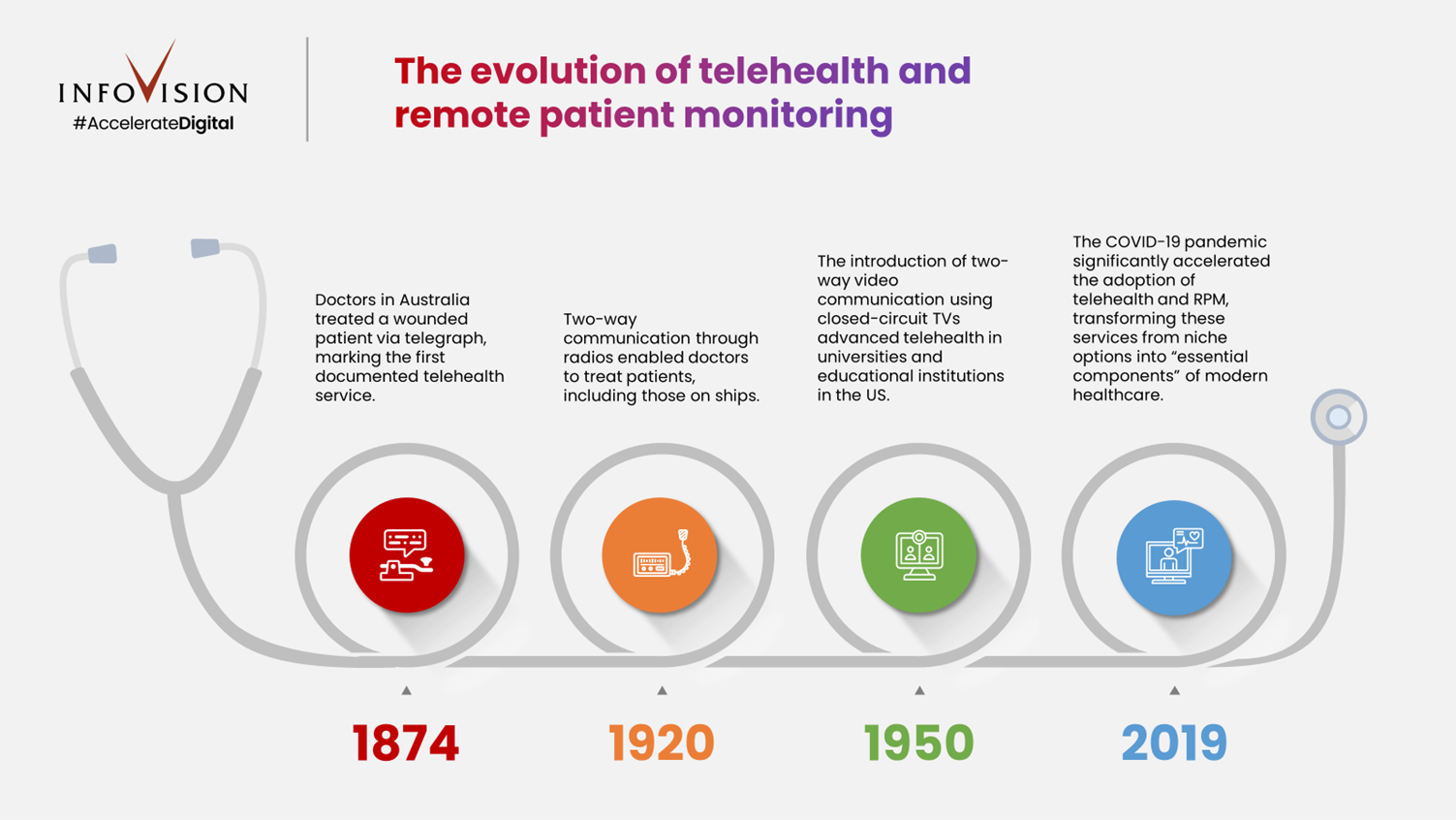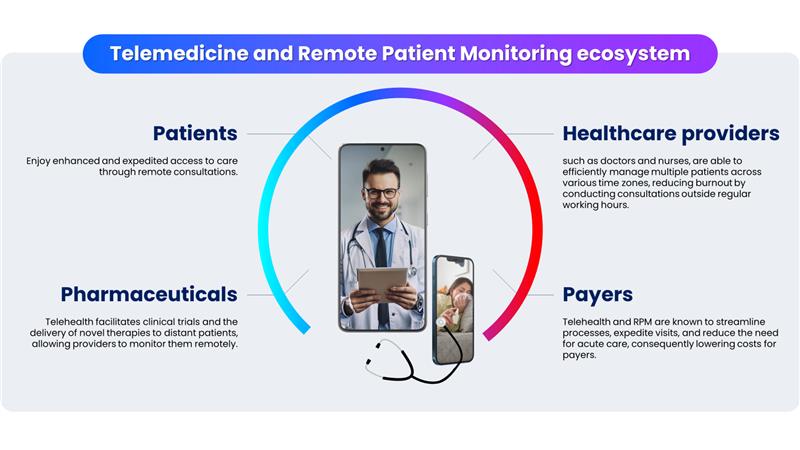The first two decades of the twentieth century saw increasing adoption of Telemedicine and Remote Patient Monitoring. The pandemic irrevocably changed one aspect of healthcare delivery - it allowed Telemedicine to move from consumer paid one-off services to mainstream healthcare delivery integrated with Provider and Payer Systems. While after the pandemic, patient interest in telemedicine has tapered or reduced, providers now see telemedicine as a key option to avoid burn-out of clinicians rushing physically from one location to another. Telemedicine can often provide faster and better experiences to rural patients, reduce doctor and nurse burn-out, can bring novel therapies and clinical trials to say, cancer patients, among many other benefits.
Telehealth and RPM have enabled the industry to close the gap between patients, caregivers, and providers pivoting around advanced technologies. From virtual consultations to monitoring patients remotely, these innovations offer unprecedented access to quality care. While Telehealth and RPM are not entirely new concepts, many healthcare stakeholders have realized their potential in the recent years, enthused with the prospect of making healthcare accessible to everyone.

Moving to the mainstream
Most Telehealth services were “consumer-paid” in the pre-pandemic era; but the need to minimize in-person visits drove rapid integration of virtual consultations and RPM into payer and provider systems. This shift potentially solidified telehealth and RPM as mainstream healthcare solutions and are no doubt here to stay. In fact, a recent survey clearly indicates that the “online doctor consultations segment” of the digital health market is projected to add 13.7 million users between 2024 and 2028, approximating an 11.74% increase. Such radical shifts are happening across the globe. Many countries are jumping onto the Telehealth bandwagon and enacting supportive legislation in recent years.
For instance,
- In Brazil, the Federal Law No. 14,510/2022 came into force in December 2022, incorporating Telehealth into their healthcare system.
- In Croatia, Telehealth is regulated by Law 1419 of 2010, issued by the Ministry of Health.
These laws and requirements supplement the existing regulations and authorizations needed to provide general health services.
The new healthcare model is here to stay
Telehealth and RPM bring a wealth of benefits to care delivery, benefiting everyone in the healthcare ecosystem.
- Patients - Enjoy enhanced and expedited access to care through remote consultations.
- Healthcare providers - such as doctors and nurses, are able to efficiently manage multiple patients across various time zones, reducing burnout by conducting consultations outside regular working hours.
- Pharmaceutical perspective - Telehealth facilitates clinical trials and the delivery of novel therapies to distant patients, allowing providers to monitor them remotely.
- Payers - Telehealth and RPM are known to streamline processes, expedite visits, and reduce the need for acute care, consequently lowering costs for payers.
Continuous monitoring of patients’ health conditions with the help of technologies such as data analytics, leading to timely interventions and improved management of chronic illnesses are one of the biggest attractions of this modern approach. The additional advantage of scalability ensures that healthcare services remain adaptable to the needs of a growing population, maintaining accessibility and effectiveness even during periods of heightened demand or resource constraints. In fact, according to a Rock Health report, 80% of people have used a telemedicine service at least once.
Furthermore, telehealth enhances the efficiency of healthcare delivery and democratizes access to medical expertise, particularly in underserved areas. Individuals with unique medical needs, such as those with disabilities, physical limitations, or age-related issues, greatly benefit from telehealth. It provides them with access to specialized care without the need for travel, ensuring they receive timely and convenient healthcare from the comfort of their homes. This is especially impactful for people residing in remote regions, such as rural Washington, where traveling long distances for basic healthcare services is often burdensome and time-consuming.
Why are people adopting Telehealth and RPM?
People are adopting Telehealth and RPM for several compelling reasons. These tech-driven solutions have proven highly effective in various therapies and indications. By closely monitoring a patient’s condition, these technologies ensure smooth transitions between different pharmaceutical services, preventing confusion and discontinuation. Moreover, telehealth facilitates collaboration with clinics, providing patients with a comprehensive view of their healthcare journey. This ensures continuity and a better understanding of their treatment progress, which is crucial for effective healthcare delivery.
Remote health monitoring of patients in their home is another big reason. After hospital discharge, patients often lose healthcare oversight, leading to avoidable readmissions and distress. Telehealth offers continuous supervision, preventing relapses into acute conditions and reducing hospitalizations, thereby reducing both financial strain and emotional stress for patients and caregivers. For example, Lee Health, Florida, RPM has successfully reduced 30-day readmission rates by 50%, highlighting the tangible benefits of integrating telehealth into post-discharge care pathways.

The last few years have marked a profound transformation in healthcare delivery, with a surge in telehealth adoption. Compared to the pre-pandemic era, where telehealth visits accounted for merely 1%, current statistics show a remarkable increase, with approximately 14–17% of visits now conducted through telehealth channels. Furthermore, telehealth has played a pivotal role in bridging the gap between physicians and family members, who are crucial in supporting patient recovery. In response to this shift, healthcare facilities have significantly expanded their telehealth capabilities, such as telehealth training for professionals, mobile health applications, and more, reflecting a positive evolution in healthcare delivery.
The central role of data and technology
Data and technology form the backbone of Telehealth and RPM, driving innovation in modern healthcare delivery. Advanced monitoring devices and sensors enable the remote collection of patient data, facilitating continuous tracking of health status. Real-time communication platforms allow for seamless virtual consultations, supported by electronic health records that ensure easy access to patient information. Dedicated telehealth platforms provide the infrastructure for virtual care services, enabling appointment scheduling and e-prescriptions. One cannot overemphasize the role of analytics in elevating the overall telehealth experience for patients as well as providers. Digital health solutions monitor side effects, manage current medications and therapies, and track Patient-Reported Outcomes (PROs). Patients at home tend to be more comfortable, which can lead to more accurate reporting of symptoms and side effects. PROs are particularly valuable as they provide direct insights into the patient’s condition and experience. By collecting and analyzing this data, healthcare providers can gain a more accurate understanding of the patient’s health status and tailor treatments accordingly. This continuous feedback loop ensures that interventions are timely and effective, ultimately leading to better health outcomes.
Addressing challenges for improved effectiveness
While Telehealth has made good strides in healthcare delivery, there are a good number of challenges that still remain to be navigated. Providers, for instance, will have to negotiate complex issues to ensure effective and efficient remote care. From integrating disparate data systems to maintaining patient privacy, and from educating users to dealing with regulatory complexities, each challenge requires careful consideration and robust solutions. Here are some of the key obstacles healthcare providers face in the realm of telehealth:
- Integrating data from various platforms and standalone applications is complex. This requires sophisticated interoperability solutions to ensure seamless communication and a comprehensive view of patient health.
- Educating both patients and healthcare providers on how to use telehealth technologies effectively is also a crucial and challenging task.
- Data privacy remains a significant concern, necessitating robust security measures to protect sensitive patient information, thus ensuring trust.
- Navigating the complex landscape of compliance and regulations, which vary by region, adds another layer of difficulty.
- Reliable technological infrastructure is essential for telehealth success but costly to maintain, particularly in areas with poor internet connectivity.
- Variability in reimbursement policies affects the adoption and sustainability of telehealth practices. Ensuring patient engagement and providing ongoing technical support are critical for the smooth operation of telehealth services.
Providers must use solutions that can help navigate such tides. In a recent webinar, I exchanged my views with industry experts on the essential features required in today's Telehealth solutions to ensure a superior patient experience. Watch the webinar on-demand to learn more.
Partnering with domain and technology experts is the key to building such robust solutions and minimizing roadblocks. At InfoVision, we are excited to partner with diverse healthcare businesses in building innovative, technology-driven solutions and contributing to the future of modern healthcare.
With over 25 years of delivery through 11 centers, InfoVision offers electronic data capture, lab informatics, and remote monitoring. Our digital and innovation services support customer, patient, and enterprise technology stacks, and are driven by 130+ technologists and cross-functional teams. We specialize in robust technology solutions for addressing key challenges in telehealth. We help providers reduce clinical trial time and costs with data warehousing, data analytics, collaboration, automation, and Artificial Intelligence (AI). Our end-to-end solutions adhere to HIPAA, GXP, CSV, 21 CFR Part 11, and other regulatory guidelines.
The future of digital healthcare
Telehealth and RPM are poised to become increasingly integral parts of the healthcare landscape, transforming the industry as we know it. With the rapid pace of advancement, these technologies are expected to seamlessly integrate into clinical workflows, promising a smoother experience for patients and providers alike. It's crucial for healthcare stakeholders to seize this opportunity and harness the power of data to develop robust telehealth solutions. By doing so, we can make healthcare more affordable, accessible, and compliant than ever before.
InfoVision uses diverse technologies to transform healthcare delivery and improve patient outcomes. Connect with us today to learn more about how we can help you in building robust healthcare delivery systems.

